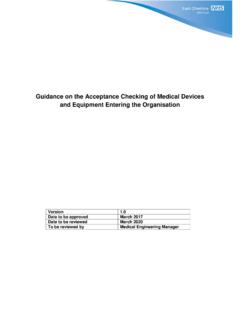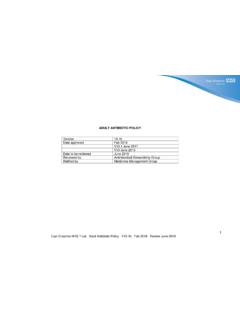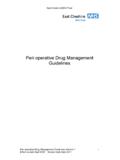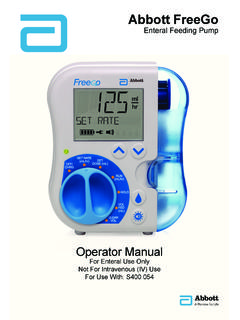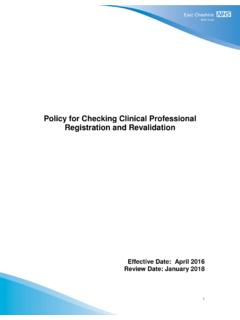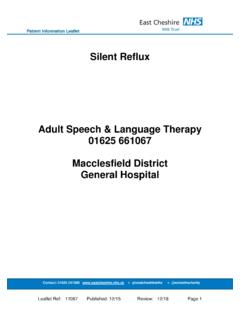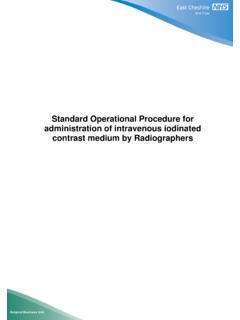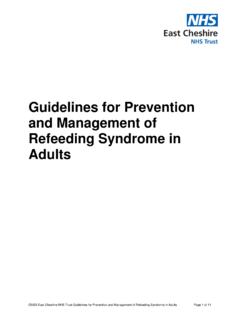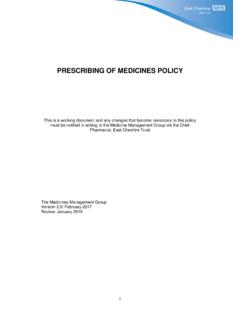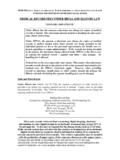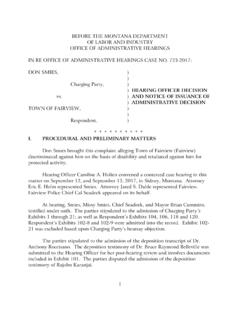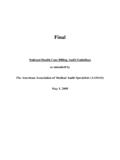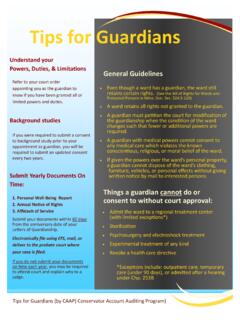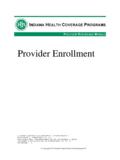Transcription of Medical Device and Equipment Management Policy
1 Medical Device and Equipment Management Policy 2 Policy Title: Medical Device AND Equipment Management Policy Executive Summary: The purpose of this Policy is to ensure that all devices and Equipment legitimately brought into the organisation: 1. Are suitable for their intended purpose 2. Offer compatibility with current Equipment and clinical practice 3. Meet clinical needs and are understood by the trained users 4. Operates in a safe and serviceable condition 5. Complies with safety and quality standards 6. Identifies capital and revenue consequences for budgetary purposes The Policy describes the systems and processes to manage the risks identified above. It has been designed to satisfy guidance published by the National Audit Office and the Medicines and Healthcare Products Regulatory Agency (MHRA). Supersedes: V3 Description of Amendment(s): Updated references Compliance monitoring and reporting This Policy will impact on: All users of Medical Equipment and devices Financial Implications: Policy Area: Medical Device Management Document Reference: ECT002918 Version Number: Effective Date: March 2018 Issued By: Medical Director Review Date: March 2021 Author: Medical Engineering Manager Impact Assessment Date: N/A APPROVAL RECORD Committees / Group Date Consultation: Medical devices Group October 2017 Risk Management Sub Committee January 2018 Approved by: Risk Management Sub Committee January 2018 3 Contents.
2 Section Title Page Introduction 4 Legislation and guidance 4 Policy Statement 4 Medical Device definition 5 Managerial and users responsibilities 5 Lifecycle Management of devices 7 Evaluation, selection and acquisition 7 Standardisation 8 Single use devices 8 Acceptance testing of new Equipment prior to use 8 Deployment and use of devices 8 Decommissioning and disposal 9 Reporting adverse incidents and disseminating Medical Device alerts 10 Manufacturer s instructions: user and technical manuals 10 User training and competency assessment 11 Prescription and loan of devices to patients 12 Maintenance and repair of Equipment 12 Monitoring compliance 14 Policy review 14 References 14 Appendices A Definition of a Medical Device 15 B New product request form 17 C Medical devices group organisational make up 22 D Example fault reporting and contamination status form 23 4 1 Introduction Medical devices and Equipment play a key role in healthcare.
3 They are vital for diagnosis, monitoring, rehabilitation and care. Effective Management of this important resource is necessary to provide safe and high quality patient care, clinical and financial governance, including minimising risks relating to adverse incidents. There is a risk that the Trust could be subject to litigation if it could not be proved that there were Management systems in place to deal with this. Good Medical Device Management will greatly assist in reducing their potential for harm. 2 Legislation and guidance The MHRA recommends a Medical Device and Equipment Management system that promotes the safe use of Medical devices for effective healthcare. Care Quality Commission: Guidance for providers on meeting the regulations (2015) references Regulation 15 of the Health and Social Care Act 2008 (Regulated Activities) Regulations 2014, states that Equipment used by the service provider must be 1) Kept clean and cleaning must be done in line with current legislation and guidance 2) Suitable for the purpose for which it is being used.
4 It should only be used for its intended purpose and by the person for whom it is provided 3) Stored securely, properly used and maintained in line with manufacturer s instructions 4) Appropriately located for the purpose for which it is being used. This means that it must be available when needed, or obtained in reasonable time as not to pose a risk to the person using the service. Providers must also ensure that staff and others who operate Equipment are trained to use it properly. East Cheshire NHS Trust has a duty of care towards its employees and patients to ensure that they are not put at risk, from Medical devices that are not managed appropriately, may be unsafe or unsuitable, are not maintained or who s operation is not understood by the user. 3 Policy Statement This Policy describes the systems to manage and mitigate the risks associated with the acquisition, deployment, planned preventative maintenance, repair and disposal of Medical devices within the organisation.
5 It also gives guidance on user training. Amongst others, this Policy is based on the recommendations of the MHRA document Managing Medical devices Guidance for healthcare and social services organisations (April 2015). 5 4 Medical Device definition The Medical devices Directive (MDD) 1998 harmonised the regulatory requirements for Medical devices within the EU, including the UK, and defines a Medical Device as: Any instrument, apparatus, appliance, material or article, whether used alone or in combination, including the software necessary for its proper application intended by the manufacturer to be used for human beings for the purpose of: Diagnosis, prevention, monitoring, treatment or alleviation of disease Diagnosis, monitoring, treatment, alleviation of or compensation for an injury or handicap Investigation, replacement or modification of the anatomy or of a physiological process, which does not achieve its principle intended action in or on the human body by pharmacological, immunological or metabolic means, but may be assisted in its function by such means.
6 This Policy is applicable to ALL Medical devices and Equipment in use within the Trust, either purchased directly or through Trust funds, public donations, loan, lease, hire, consumables deals and free gifts. A non-exhaustive list of types of Medical devices can be found in Appendix A. 5 Managerial and Users Responsibilities Chief Executive The Chief Executive is the duty holder on behalf of the Trust Board and has ultimate responsibility for all policies and their implementation. Medical Director The Medical Director is accountable for ensuring that there are systems and processes in place for the safe use and Management of Medical devices across the trust. Director of Finance and Facilities (DoFF) The Director of Finance and Facilities is the Executive Director responsible for maintenance services and assumes delegated responsibilities of the Chief Executive for maintenance. He/she has overall responsibility for the Estate Services, including the Medical Engineering Department.
7 Medical devices Safety Officer (MDSO) The Medical devices Safety Officer (Clinical and Professional Development Training Manager) is responsible for coordinating Medical Device safety and Management arrangements across the organisation. He/she is the key point of contact for Medical Device related queries and is responsible for reporting Medical Device related adverse incidents to MHRA and other official agencies. Head of Estates The Head of Estates has responsibility for the Estate Services, including Medical Engineering. 6 Estates Operations Manager The Estates Operations Manager has operational responsibility for the Estate Services, including Medical Engineering. He/she ensures that existing resources are used in an efficient manner. Medical Engineering Manager The Medical Engineering Manager is the author of the Policy and will monitor, evaluate and review the Policy within the Medical Engineering Department.
8 He/she has managerial responsibility of the Medical Engineering Team, maintenance, inspection, repair, and decommissioning of the Trust Medical Equipment in line with current legislation and will ensure that the Policy is implemented within the Medical Engineering Department. The Medical Engineering Manager is not responsible for Medical devices and Equipment that are managed under separate service contracts by other departments. Medical Engineering Team The Medical Engineering Team will be responsible for ensuring that reusable portable electro-mechanical Medical Equipment is appropriately acceptance checked and documented accordingly, following notification of receipt. All in-house maintenance will be carried out in accordance with MHRA and manufacturer s guidance and time frames where applicable. Procurement Team The Procurement Team is responsible for ensuring that newly delivered Medical devices and Equipment are compatible with the specifications set out in the purchase order document.
9 They act as primary liaison between the Trust and the supplier in the event of damaged or inappropriately delivered Equipment . Medical devices Facilitators The Medical devices Facilitators are responsible for ensuring appropriate updating of the Medical devices training records and devices register following notification of receipt of or withdrawal of Equipment from the Trust. Deputy Directors/Heads of Service and Ward/Department Managers The managerial responsibility for the implementation of this Policy remains with the Deputy and Associate Directors, General and Operational Managers and Ward/Department Managers. They should ensure that key clinical staff are identified and are responsible for the operation implementation and monitoring of this Policy within their own clinical and other areas of work. They are responsible for ALL devices in use on their areas at all times. Therefore as owners of this Equipment , it is their responsibility to ensure that all their Equipment is maintained adequately to the manufacturer s recommendations and timeframe, including external maintenance contract provisions.
10 Incidents relating to Medical devices should be reported via the Datix incident reporting system. All users of Medical devices All users of Medical devices are responsible for ensuring that appropriate acceptance checks have been carried out on newly delivered Equipment , that it is fit for purpose, is serviceable and safe to use, and that its operation is understood. 7 6 Lifecycle Management of devices The Management of Medical devices involves its lifecycle. This requires a systematic approach to the following: Acquisition, including identifying the need for the Device . Acceptance checking pre-use Deployment Maintenance and performance verification Repair Disposal of redundant/obsolete devices , including safe decommissioning A vital part of effective Medical Device Management is the creation and maintenance of Equipment inventories for Equipment in use within the Trust. The Medical Engineering Department is responsible for maintaining a computerised inventory of the Equipment it maintains.
